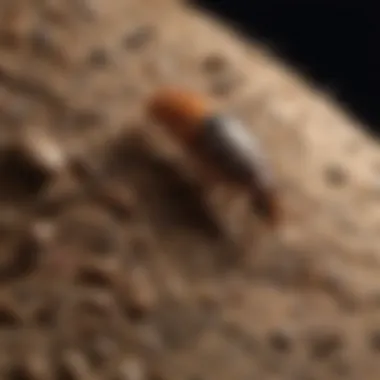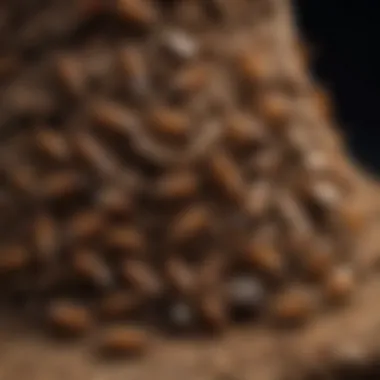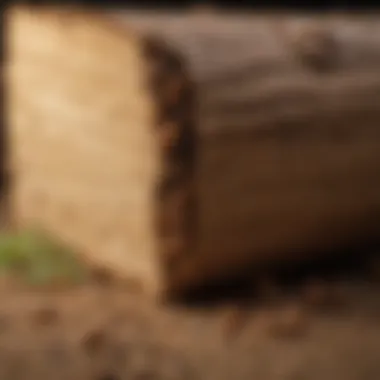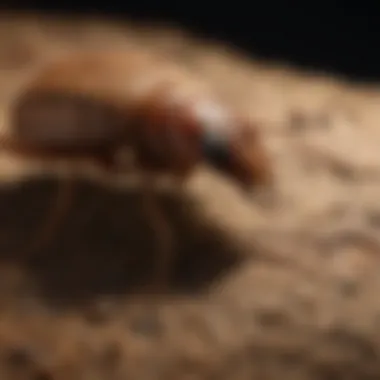Understanding Termites at Night: Behavior & Control


Intro
Termites are fascinating creatures, particularly because of their nocturnal behavior. Most people are unaware that these insects actively engage in their routines during the night. This article will explore the reasons behind this behavior and its implications for pest control. Understanding termite activity at night is essential for homeowners and pest management professionals alike. This knowledge can lead to improved identification and management of potential infestations.
Identification of Common Pests
Description of Common Pests
Among various species of termites, the most common types found in households include the Eastern subterranean termite, Western drywood termite, and Formosan termite. Each species has distinct characteristics. Subterranean termites tend to live underground and build networks of tunnels, while drywood termites inhabit wooden structures, often remaining concealed in the wood. Formosan termites are known for their aggressive nature and large colonies. Knowing these distinctions helps in accurate identification and understanding of the threat posed by these pests.
Signs of Infestation
Recognizing the signs of termite infestations is crucial. Some tell-tale signs include:
- Mud tubes: These are pencil-sized tunnels created by termites to protect themselves as they travel between their nests and food sources.
- Wood damage: Hollowed or weakened wood often indicates termite activity.
- Swarmers: Winged termites, especially during spring, indicate the potential for a colony nearby.
- Droppings: Small piles of fecal pellets left near wood structures can signal an infestation.
Termites often cause extensive damage before their presence is even suspected. Homeowners should remain vigilant and inspect their properties regularly.
Prevention Techniques
Home Maintenance Tips
Preventing termite infestations starts with good home maintenance. Regular inspections are necessary to identify any potential issues. Keeping wood away from the foundation of the house can reduce exposure. Sealing cracks and gaps can help to limit entry points for these pests. Also, it is important to fix any leaks that could provide moisture, which termites require.
Environmental Modifications
Your surrounding environment also plays a role in termite prevention. Removing wood debris and maintaining a dry environment around the house will discourage termite activity. Additionally, ensuring proper drainage can prevent flooding or standing water, which attracts termites.
Eco-Friendly Pest Control Options
Natural Pesticides
When it comes to pest control, many homeowners prefer eco-friendly options. Natural pesticides such as diatomaceous earth work effectively against termites. It is non-toxic to humans and pets but deadly to insects. Applying it in areas where termite activity is suspected can serve as a barrier against infestations.
Organic Pest Control Techniques
In addition to natural pesticides, other effective organic pest control techniques include the use of nematodes. These microscopic worms attack termites directly. Homeowners can introduce nematodes into affected areas, targeting termite colonies without harming beneficial insects. These methods promote a healthier environment while managing pest problems effectively.
By understanding termites and their nocturnal nature, homeowners can better protect their properties. Equipped with appropriate knowledge and strategies, managing termite infestations becomes more straightforward and effective.
Preface to Termites
Understanding termites is crucial for anyone concerned about property maintenance. These insects can silently cause extensive damage to wooden structures, making awareness about their behavior and management essential. This article aims to provide a comprehensive overview of termites, focusing on their nocturnal habits, which can pose challenges for homeowners and pest control professionals alike.
Homeowners may not realize that termites are not just daytime pests. Understanding their nighttime activity can lead to early detection and effective control measures. Knowledge about their social structure and ecological role also informs how one can manage their presence.
Being informed on termite behavior can prevent costly repairs and give homeowners peace of mind. Below, we will define what termites are, and explore their ecological significance.
Defining Termites
Termites belong to the order Blattodea, closely related to cockroaches. They are small, social insects that live in colonies, which can range from a few hundred to millions of individuals. Termites are predominantly recognized for their wood-eating habits. They consume cellulose, a primary component of wood, paper, and other plant materials.
These insects can be categorized into various species, including drywood, subterranean, and dampwood termites. Each type has distinct habitats, behaviors, and challenges that homeowners may face. For instance, subterranean termites usually build their colonies underground, while drywood termites nest within the wood they consume.
Ecological Role and Importance
Termites play a vital role in ecosystems. They contribute to soil health by breaking down dead plant material. This process recycles nutrients back into the soil, making them available for plants. Without termites, dead organic matter would accumulate, thus negatively impacting the environment.
Their tunneling activities aerate the soil, allowing for better water infiltration and root growth. Despite the damage they may cause to human structures, they are essential for maintaining ecological balance.
Termites are also considered a food source for various predators, including birds, reptiles, and mammals. Their presence reflects a healthy ecosystem, making them important beyond the realm of pest management. Understanding both their ecological role and their threats helps homeowners approach termite control with a more informed perspective.
Nocturnal Activity of Termites
Understanding the nocturnal activity of termites is crucial for homeowners and pest control professionals alike. Termites exhibit specific behaviors at night that influence their social interactions, feeding practices, and reproductive cycles. This nocturnal behavior presents unique challenges when it comes to detection and management. Both knowledge and awareness of these activities allow for better strategies in preventing infestations and minimizing structural damage.


Reasons for Nighttime Activity
Termites tend to be more active during the night for several reasons. One primary factor is temperature regulation. Nights are generally cooler than days, which helps in maintaining a suitable environment for these insects. Additionally, nighttime activity reduces the risk of predation from birds and other daytime predators.
Another important aspect is moisture levels. At night, humidity tends to increase, creating a more favorable condition for termites, which thrive in damp environments. This factor plays a vital role in their foraging patterns and colony dynamics. Moreover, nocturnal activity allows termites to navigate and access resources with less interference from external factors, such as heat and light.
Impact of Environmental Factors
Temperature Variations
Temperature variations significantly impact termite behavior and activity. Generally, termites prefer temperatures ranging from 70 to 90 degrees Fahrenheit. Extreme heat can be detrimental, making nighttime the optimal time for foraging and other colony tasks. This preference leads to more structured colony activities during the cooler hours, ultimately assisting in growth and maintenance.
High temperatures during the day can deter termites from functioning efficiently, whereas the cooler nights support more active and fruitful periods of scavenging for food and establishing new colonies. Understanding temperature influences can greatly benefit pest management efforts.
Humidity Levels
Humidity levels play a crucial role in termite activities. Termites require moisture to survive. During the night, humidity levels often rise, creating an ideal environment. This increase enables termites to forage for food without expending excessive energy to mitigate dehydration.
Furthermore, high humidity promotes wood decay, which draws termites to their food sources. The connection between humidity levels and termite behavior emphasizes the need for thorough monitoring of moisture in and around homes. Acknowledgment of these dynamics enables homeowners to make informed choices when managing their properties.
"Termites are drawn to moist environments, making nighttime a critical period for their activity and assessment of potential threats to structures."
Biology of Termites
Understanding the biology of termites is crucial for appreciating their behavior, especially their nocturnal activities. The social structure and physical characteristics of termites play significant roles in their survival. These aspects also influence how pest control strategies are employed. Knowledge about the biology of termites can provide insight into their habits, enabling homeowners to recognize and manage potential infestations effectively.
Social Structure of Termite Colonies
Termite colonies are complex societies with distinct roles for each member, ensuring their communal survival. The social hierarchy includes the queen, workers, and soldiers, each with specific functions that contribute to the colony's overall health.
Role of the Queen
The queen termite is central to the colony's structure. Her primary role is reproduction, producing thousands of eggs daily. This reproductive capability is crucial for maintaining colony size and health. The queen's longevity—sometimes exceeding a decade—enables her to foster large, stable colonies. This aspect makes her presence significant in discussions regarding pest control, as her survival directly impacts the colony’s growth potential. However, the queen may be vulnerable to targeted pest control measures, which can disrupt the colony's lifecycle.
Worker Termites
Worker termites are the backbone of the colony. They are responsible for caring for the queen and her eggs, building and repairing the nest, foraging for food, and maintaining the colony's hygiene. Their dedication to various tasks makes them key players in the colony's success. A notable characteristic is their inability to reproduce, which can be considered a disadvantage. However, their cooperative lifestyle ensures the colony thrives despite this limitation. Addressing the role of worker termites is essential for homeowners, as they are often the most visible termites during infestations.
Soldier Termites
Soldier termites offer protection to the colony. Their primary function is defense against threats, particularly from predators. Equipped with strong mandibles, they guard the nest and the workers. This role is also beneficial in terms of pest control strategies. By understanding the function of soldier termites, control measures can be more effectively targeted, minimizing collateral damage to the colony. Soldier termites are numerous, yet their inability to feed themselves presents a unique challenge. When involved in management strategies, it is essential to consider their reliance on worker termites for sustenance.
Physical Characteristics
Physical traits of termites can vary among species, but some features are fundamental to their identification and behavior. Termites are typically soft-bodied and pale in color. They have straight antennae and two pairs of wings, which they shed after swarming.
These characteristics make identification easier for homeowners. Notably, their soft bodies render them vulnerable to environmental conditions. An understanding of these traits can inform pest control methods, reinforcing the importance of timely action when signs of infestation appear. Their physical attributes not only contribute to their survival but also shape the pest management strategies available to homeowners.
Detection of Termite Infestations
Detecting termite infestations is crucial for effective management and prevention of damage. Termites can cause significant structural harm, making early detection vital for maintaining the integrity of homes. Understanding how to identify signs of their presence can save homeowners both time and money. Detection methods include recognizing physical evidence of termites and employing strategies tailored for nighttime inspections.
Identifying Signs of Termite Presence
Recognizing the signs of termite activity is the first step in prevention. Homeowners must be vigilant and familiar with indicators that termites are present. The two primary signs include frass and droppings, as well as wood damage indicators. Understanding each can improve the likelihood of early detection.
Frass and Droppings
Frass refers to the droppings of termites, which are often wood-colored pellets. They serve as a telltale sign of an active infestation. Recognizing frass can be beneficial for homeowners because it indicates that termites have been feeding within wooden structures.
Key characteristics of frass include:
- Appearance: The pellets resemble tiny grains and vary in size depending on the species.
- Location: Frass is typically found in areas where termites are active.
The unique feature of frass is its consistency. It is often mistaken for sawdust, but careful observation can reveal its true nature. Understanding how to distinguish this can help in accurately identifying an infestation.


Advantages of monitoring for frass include:
- Early warning: Frass indicates ongoing activity, prompting timely pest management actions.
- Location identification: It can help pinpoint specific sites of damage within the home.
However, relying solely on frass may not provide a complete picture. It is best used in conjunction with other identification methods.
Wood Damage Indicators
Wood damage indicators are another essential sign of termite presence. This can include hollowed-out wood, broken sections, or surfaces that crumble easily. Recognizing these indicators can prevent larger structural issues later on.
Key characteristics of wood damage include:
- Hollow sounds: Tapping wooden structures may reveal hollow sounds where damage is present.
- Surface damage: Cracks or discoloration on the wood surface can also signify termite activity.
The unique feature of wooden structures damaged by termites is the pattern. Termites tend to leave a thin layer of wood on the surface while consuming the inner part. This characteristic damage can often be mistaken for natural wear and tear.
Advantages of assessing wood damage indicators include:
- Comprehensive understanding: Identifying these signs can offer insight into the extent of the infestation.
- Direct action: Recognizing damage encourages homeowners to take immediate preventive measures.
Nighttime Inspection Techniques
Since termites are mostly active at night, nighttime inspection techniques become essential for thorough detection. Utilizing proper tools and strategies is necessary for effectively spotting signs of infestation during the dark hours.
Some techniques include:
- Using UV lights: Termite paths are visible under UV light due to the fluorescence of their bodies.
- Careful listening: Placing an ear against suspected infested areas may help detect the sounds of feeding.
By embracing both standard and innovative techniques, homeowners can better position themselves to detect termite activity early, ultimately reducing the risk of extensive damage.
Risks Associated with Termites Active at Night
Understanding the risks associated with nocturnal termite activity provides valuable insight into effective pest management. Termites are often considered silent destroyers. Their ability to cause extensive damage while homeowners are oblivious is alarming. Awareness of their behavior, particularly at night, is crucial for minimizing harm. Nighttime activity creates opportunities for infestations to grow unchecked. This can result in significant financial burdens and safety hazards for property owners.
Structural Damage
Termites primarily feed on wood, which can lead to severe structural damage in and around the home. The problem is aggravated at night when termites are most active. Infestations that go unnoticed can spread rapidly, consuming the wood that forms essential structural components like beams, joists, and even flooring.
Indicators of such damage may often remain hidden until visible physical signs appear, causing homeowners to underestimate their presence. Signs like hollow-sounding wood or visible tunnels may only emerge after considerable damage has already occurred. The impact on a home’s integrity can result in costly repairs or even unsafe living conditions.
Why This Matters:
- Financial implications: Repairing structural damage cost can escalate quickly.
- Safety risks: Compromised structures can lead to accidents or injuries.
Health Concerns Related to Infestations
Beyond structural issues, termite infestations also pose potential health risks. They can create conditions that allow mold and mildew to thrive, especially in damp areas caused by tunneling and nesting. Mold spores are a common household allergen. They can exacerbate respiratory problems and other health issues.
Furthermore, the wood debris and droppings left behind by termites can attract other pests, which may carry diseases.
In summary: The increased risk of health issues associated with pests underscores the importance of nocturnal termite activity monitoring.
Effective Pest Control Strategies
The approach to pest control requires meticulous planning and awareness, especially when dealing with nocturnal insects like termites. Understanding effective pest control strategies is crucial for homeowners and pest management professionals alike. Termites usually cause significant structural damage when they go undetected. A thorough strategy encompasses both preventive measures and reactive solutions to deal with infestations.
By implementing these strategies, homeowners can minimize the risk of infestations and protect their properties. Effective control not only safeguards the physical structure of homes but also helps reduce the associated financial burdens of dealing with serious infestations.
Preventive Measures for Homeowners
Preventive measures stand as the first line of defense against termites at night. Homeowners should focus on maintaining a dry environment, as moisture attracts termites. Here are some key practices:
- Regular Inspection: Frequent examinations of the property, especially in areas susceptible to moisture, can help identify early signs of termite activity.
- Wood Treatment: Using borate-based wood treatments can protect wood from termite damage.
- Lawn Care: Keeping plants and shrubs away from the home’s foundation decreases the likelihood of termite entry.
- Foundation Maintenance: Ensure that the foundation is clearly visible, and fill any cracks or crevices where termites may find a way in.
Each preventive measure contributes to a comprehensive strategy to combat nocturnal termites, which can quietly cause damage while homeowners sleep.


Eco-Friendly Pest Control Solutions
Several eco-friendly methods exist that can effectively manage termite populations without harming the environment. These solutions focus on sustainable practices that align with the increasing demand for environmentally sensitive pest control options.
Boric Acid
Boric acid is a popular choice among eco-friendly pest control solutions. This naturally occurring compound is effective against termites because it disrupts their digestive systems when ingested. Key characteristics of boric acid include its low toxicity to humans and pets, making it a safer alternative to conventional pesticides.
Advantages of Boric Acid:
- Effectiveness in killing termites by dehydrating them.
- Long-lasting protection if applied correctly.
- Minimal environmental impact.
Disadvantages of Boric Acid:
- Requires proper application to ensure effectiveness.
- Efficacy may vary depending on termite species.
Boric acid's unique feature lies in its ability to be used both as a preventive treatment and as a remedy for existing infestations.
Essential Oils
Essential oils also provide an eco-friendly alternative for termite control. Oils like clove and neem contain natural compounds that repel or kill pests while being safe for the environment. The key characteristics of essential oils include their potent and pleasant scent, which does double duty in repelling termites and providing a fresh aroma to the treated area.
Advantages of Essential Oils:
- Naturally sourced and sustainable.
- Simple application methods, including spraying or diffusion.
Disadvantages of Essential Oils:
- May require frequent reapplication.
- Limited effectiveness compared to chemical solutions in severe infestations.
Essential oils appeal to homeowners seeking a less toxic form of pest control while still maintaining safety for their families and pets.
"Implementing effective pest control strategies is essential in safeguarding your home from the hidden damages caused by nocturnal termites."
Employing both preventive measures and eco-friendly solutions provides a balanced approach to effective termite management. Homeowners can achieve peace of mind, protecting their properties while contributing to a healthier planet.
Long-Term Management of Termite Infestations
Long-term management of termite infestations is crucial for maintaining structural integrity and protecting your home. Understanding the behaviors of termites, particularly their nocturnal activities, helps homeowners take preventive actions before significant damage occurs. Constant vigilance coupled with strategic responses can mitigate risks and ensure a pest-free environment.
Regular Inspections and Monitoring
Regular inspections are essential in identifying termite activity early. Homeowners should check for signs of infestation, such as mud tubes, swarmer wings, and wood damage. It is important to inspect areas where wood comes in contact with soil, including foundations and basements.
Homeowners can adopt these practices for effective monitoring:
- Scheduled Inspections: Conduct inspections at least once a year. Focus on high-risk areas and potential points of entry.
- Utilize Technology: Some options like infrared cameras can detect heat variations that may indicate termite presence.
- Educate Yourself: Learn about the signs of termite activity to identify issues promptly. Information can often be found on sites like Wikipedia or the Britannica.
Monitoring your home not only prevents infestations but also saves money on repairs that would result from extensive damage.
Engaging Professional Pest Control Services
While regular self-inspections are important, sometimes professional intervention is necessary. Engaging with pest control experts provides several benefits:
- Expertise: Professionals bring knowledge that is difficult to replicate. They can spot signs of termites that may be missed by untrained eyes.
- Advanced Treatments: Experts use more advanced methods and products for management, which are often effective for a longer duration compared to DIY solutions.
- Insurance and Guarantees: Many pest control companies offer warranties or guarantees on their work. This can provide peace of mind for homeowners worried about future infestations.
Regular Inspections and Monitoring Regular inspections are essential in identifying termite activity early. Homeowners should check for signs of infestation, such as mud tubes, swarmer wings, and wood damage. It is important to inspect areas where wood comes in contact with soil, including foundations and basements. Homeowners can adopt these practices for effective monitoring: - Scheduled Inspections: Conduct inspections at least once a year. Focus on high-risk areas and potential points of entry. - Utilize Technology: Some options like infrared cameras can detect heat variations that may indicate termite presence. - Educate Yourself: Learn about the signs of termite activity to identify issues promptly. Information can often be found on sites like Wikipedia or the Britannica. Monitoring your home not only prevents infestations but also saves money on repairs that would result from extensive damage. Long-Term Management of Termite Infestations\n\nLong-term management of termite infestations is crucial for maintaining structural integrity and protecting your home. Understanding the behaviors of termites, particularly their nocturnal activities, helps homeowners take preventive actions before significant damage occurs. Constant vigilance coupled with strategic responses can mitigate risks and ensure a pest-free environment.\n\n Regular Inspections and Monitoring\n\nRegular inspections are essential in identifying termite activity early. Homeowners should check for signs of infestation, such as mud tubes, swarmer wings, and wood damage. It is important to inspect areas where wood comes in contact with soil, including foundations and basements. \n\nHomeowners can adopt these practices for effective monitoring:\n\n- Scheduled Inspections: Conduct inspections at least once a year. Focus on high-risk areas and potential points of entry.\n- Utilize Technology: Some options like infrared cameras can detect heat variations that may indicate termite presence.\n- Educate Yourself: Learn about the signs of termite activity to identify issues promptly. Information can often be found on sites like Wikipedia or the Britannica.\n\nMonitoring your home not only prevents infestations but also saves money on repairs that would result from extensive damage. \n\n
Finale
The conclusion ties together the various insights from the article, focusing on the nocturnal behavior of termites and the corresponding implications for pest control. By understanding the specific patterns and reasons for termite activity at night, homeowners and pest management professionals can improve both prevention and detection efforts.
Summarizing Key Insights
Understanding termites necessitates an appreciation of their nocturnal habits. Key insights include:
- Nocturnal Activity: Termites tend to be more active at night due to environmental factors that favor their behavior. Cooler temperatures and higher humidity in the dark help them thrive.
- Detection Strategies: Recognizing signs of infestation, especially at night, can prevent extensive damage. Homeowners should be keen to identify wood damage or frass even when visibility is low.
- Impact on Structures: Nighttime activities lead to significant structural concerns. This highlights the need for proactive measures against infestations.
- Eco-Friendly Solutions: Knowledge about safe pest control methods can significantly enhance your efforts in managing termites without harming the environment.
Final Thoughts on Termite Management
In essence, termite management extends beyond mere treatment; it involves a thoughtful approach to prevention and sustained monitoring. Engaging with pest control professionals can ensure that the latest methods are employed effectively. Understanding the nocturnal nature of termites empowers homeowners to be vigilant, and an informed strategy helps mitigate risks associated with infestations.
Ultimately, diligent observation and timely interventions can preserve structures and maintain home environments in pristine condition. For further reading, explore resources like Wikipedia and Britannica for comprehensive information on termite biology and management.







